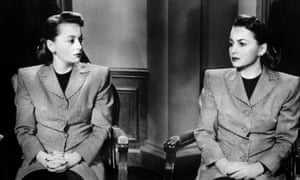
Olivia de Havilland: Hollywood’s queen of radiant calm
The Gone With the Wind star, known for her lifelong feud with her sister as much as the bewitching brilliance of her acting, and the last link to Hollywood’s golden age
When De Havilland walked on the stage for the 2003 Oscars to present an award – to the crashing accompaniment of the Gone With the Wind score – this snowy-haired grandmotherly figure was greeted with a standing ovation that went on for about four minutes, a tribute to the real old school. But this is complicated. It is not just that De Havilland was one of the very few survivors of the studio system, she personally took action that effectively put an end to it. In 1943, she sued her employer Warner Brothers for adding a suspension period to her contract term for turning down a role, and won the case. Contract servitude for Hollywood stars was over and the new rule of managers, agents and high-rolling independent producers was on the rise. De Havilland had changed the way celebrity was manufactured.
She had herself won best actress Oscars for To Each His Own (1946), a smalltown romance culminating in wartime London, and The Heiress (1949), the Jamesian story of a wealthy, shy young woman who is dazzled by a charmer played by Montgomery Clift. But my favourite De Havilland movie is Robert Siodmak’s cult thriller The Dark Mirror (1946) in which she plays identical twins – with some surprisingly good and rather disturbing visual effects. One twin is a killer and the other is covering up for her, and instead of showing clearly from the outset who is the “good” and who the “bad” twin, De Havilland’s performances are coolly equivalent and it often isn’t clear which of the two we are watching. Siodmak and De Havilland contrive an eerie pair of Dr Jekylls. Audiences, I suspect, would have thrilled to the idea of De Havilland’s split personality, given how her feuding rivalry with Fontaine was starting to receive traction.
It was as if Olivia and Joan were two sides of a single Hollywood diva. Where De Havilland brought something rational and controlled to her performances, Fontaine was the fragile, emotional star of movies such as Rebecca and Letter from an Unknown Woman. Fontaine was more quiveringly vulnerable, a real Hitchcockian leading lady; she was more mercurial, more haunted, sexier.
Olivia was the sister whose acting career was favoured by her mother; their parents were grand British expatriates in Japan, whose family was connected to the aircraft manufacturer. But Joan was not allowed to take the family name, and Fontaine was the name of her stepfather.
Neither sister could quite forgive the other for being in the movies. When De Havilland stepped up to receive her Oscar for The Heiress, she appeared to ignore Fontaine’s handshake (itself a cold gesture) in retaliation for being ignored when she had tried to congratulate Joan at the ceremony after Joan won for Suspicion. Even in late middle age, the sisters quarrelled over what kind of hospital care their mother should receive. To the very last, the women were protective and proprietorial about their elderly mother – whose influence was at the heart of their two careers and stormy relationship – and Joan (who died aged 96 in 2013) was irritated beyond endurance by her older sister’s goody-two-shoes image.



Inga kommentarer:
Skicka en kommentar
Obs! Endast bloggmedlemmar kan kommentera.